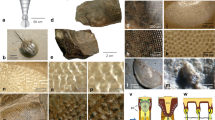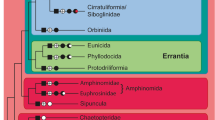Summary
The ultrastructure of the compound eyes of 13 amphipod species has been investigated. An amphipod type of compound eye can be characterized by the constellation and consistency of a number of morphological features, most of which are also found in other compound eyes. The amphipod eye falls into four sub-categories (types). The ampeliscid type has a tripartite aberrant lens eye; the lysianassid type has a reduced or no dioptric apparatus and a hypertrophied rhabdom; the hyperid type possesses a large number of ommatidial units with long crystalline cones and dark instead of reflecting accessory pigment; and finally, the gammarid type can be interpreted as a generalized amphipod type. The lysianassid type is adapted to low light intensities and demonstrates convergent development with the compound eyes of other deep-sea crustaceans. The ampeliscid type is more similar to the gammarid type. The type characterization of the amphipod compound eye might well serve as a basis and incentive for functional studies also revealing adaptational mechanisms.
Similar content being viewed by others
References
Ball, E.E.: Fine structure of the compound eyes of the midwater amphipodPhronima in relation to behaviour and habitat. Tissue Cell9, 521–536 (1977)
Debaisieux, P.: Les yeux des crustacés. Cellule50, 9–122 (1944)
Delia Valle, A.: Gammarini. Fauna Flora Golfes Neapel20, 1–948 (1893)
Donner, K.O.: On vision inPontoporeia affinis andP. femorata (Crustacea, Amphipoda). Comments Biol.41, 1–17 (1971)
Edwards, A.S.: The structure of the eye ofLigia oceanica L. Tissue Cell1, 217–228 (1969)
Eguchi, E., Waterman, T.H.: Fine structure patterns in crustacean rhabdoms. In: The functional organization of the compound eye. (C.G. Bernhard, ed.), pp. 105–124. London: Pergamon Press 1966
Elofsson, R.: Rhabdom adaptation and its phylogenetic significance. Zool. Scr.5, 97–101 (1976)
Elofsson, R., Hallberg, E.: Correlation of ultrastructure and chemical composition of crustacean chromatophore pigment. J. Ultrastruct. Res.44, 421–429 (1973)
Elofsson, R., Hallberg, E.: Compound eyes of some deep-sea and fiord mysid crustaceans. Acta Zool. Stockholm58, 169–177 (1977)
Elofsson, R., Odselius, R.: The anostracan rhabdom and the basement membrane. An ultrastructural study of theArtemia compound eye (Crustacea). Acta Zool. Stockholm56, 141–153 (1975)
Ercolini, A.: Sulla struttura degli occhi composti diTalitrus saltator Montagu (Crustacea — Amphipoda). Redia49, 129–135 (1965)
Hallberg, E.: The fine structure of the compound eyes of mysids (Crustacea: Mysidacea). Cell Tissue Res.184, 45–65 (1977)
Hanström, B.: Neue Untersuchungen über Sinnesorgane und Nervensystem der Crustaceen II. Zool. Jahrb. Abt. Anat. Ontog. Tiere56, 387–520 (1933)
Karnovsky, M.J.: A formaldehyde-glutaraldehyde fixative of high osmolarity for use in electron microscopy. J. Cell Biol.27, 137A-138A (1965)
Kunze, P.: Histologische Untersuchungen zum Bau des Auges vonOcypode cursor (Brachyura). Z. Zellforsch. Mikrosk. Anat.82, 466–478 (1967)
Laughlin, S.B., Menzel, R., Snyder, A.W.: Membranes, dichroism and receptor sensitivity. In: Photoreceptor optics (A.W. Snyder and R. Menzel, eds.), pp. 237–262. Berlin-Heidelberg-New York: Springer 1975
Meyer-Rochow, V.B.: Larval and adult eye of the western rock lobster(Panulirus longipes). Cell Tissue Res.162, 439–457 (1975)
Meyer-Rochow, V.B.: The eyes of mesopelagic curstaceans. II.Streetsia challngeri (Amphipoda). Cell Tissue Res.186, 337–349 (1978)
Michel, A., Anders, F.: Über die Pigmente im Auge vonGammarus pulex L. Naturwissenschaften41, 72 (1954)
Nässel, D.R.: The retina and retinal projection on the lamina ganglionaris of the crayfishPacifastacus leniusculus (Dana). J. Comp. Neur.167, 341–360 (1976)
Nemanic, P.: Fine structure of the compound eye ofPorcellio scaber in light and dark adaptation. Tissue Cell7, 453–468 (1975)
Nilsson, H.L.: The fine structure of the compound eyes of shallow-water asellotes,Jaera albifrons Leach andAsellus aquaticus L. (Crustacea: Isopoda). Acta Zool. Stockholm59, 69–84 (1978)
Parker, G.H.: The compound eyes in crustaceans. Bull. Mus. Comp. Zool. Harv. Univ.21, 45–140 (1891)
Richardson, K.C., Jarret, L., Finke, E.H.: Embedding in epoxy resins for ultrathin sectioning in electron microscopy. Stain Technol.35, 313–323 (1960)
Sars, G.O.: An account of the Crustacea of Norway, Vol. 1. Amphipoda. Christiania-Copenhagen: Alb. Cammermeyer 1895
Schellenberg, A.: Amphipoda des nordischen Plankton. In: Nordisches Plankton III, pp. 589–722. Kiel-Leipzig: Lipsius & Tischer 1927
Stephensen, K.: Storkrebs II. Ringkrebs 1. Tanglopper (amphipoder). København: G.E.C. Gad 1928
Strauss, E., Das Gammaridenauge. Wiss. Ergebn. dt. Tiefsee-Exped. Valdivia.20, 1–84 (1926)
Svensson, E.: Über die Augen und das Gehirn vonHaploops tubicola Lilj. Ark. Zool.25A/18, 1–15 (1933)
Wimpenny, R.S.: The plankton of the sea. London: Faber and Faber 1966
Woltereck, R.: Die Hyperiidea Gammaroidea. Bull. Mus. comp. Zool. Harv. Univ.52, 145–168 (1909)
Author information
Authors and Affiliations
Additional information
This paper is dedicated to Professor Erik Dahl on his 65th birthday and retirement from the Chair of Structural Zoology, Department of Zoology, University of Lund
The investigation has been supported by grants from the Swedish Natural Science Research Council (Grants 2760-009 and 009-43). Our thanks are due to the staffs of the marine biological stations in Espegrend (Norway) and Kristineberg (Sweden) and of the research vessel “Jean Charcot”, Brest, France. The skilled technical assistance of Mrs. Rita Wallén and Miss Maria Walles is gratefully acknowledged
Rights and permissions
About this article
Cite this article
Hallberg, E., Nilsson, H.L. & Elofsson, R. Classification of amphipod compound eyes — The fine structure of the ommatidial units (Crustacea, Amphipoda). Zoomorphologie 94, 279–306 (1980). https://doi.org/10.1007/BF00998206
Received:
Issue Date:
DOI: https://doi.org/10.1007/BF00998206




